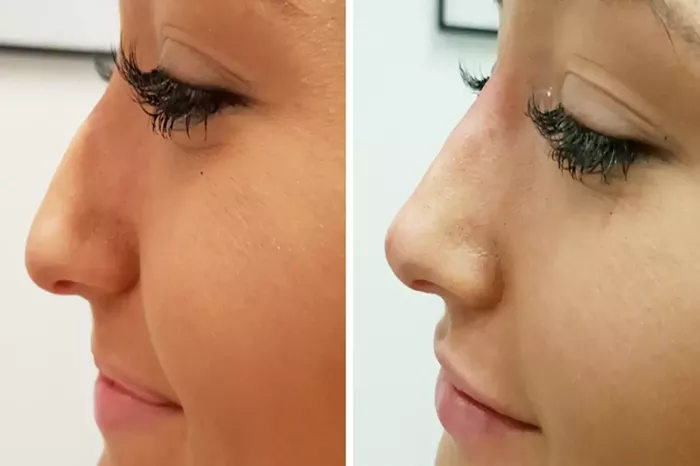The beauty industry has seen significant advancements in recent years, particularly in the field of cosmetic procedures. One such innovation is the nonsurgical nose job, also known as a liquid rhinoplasty. This procedure offers an alternative to traditional surgical rhinoplasty, promising to enhance the appearance of the nose without the need for invasive surgery. But is it worth it? This article delves into the details of nonsurgical nose jobs, examining their benefits, risks, and overall outcomes.
Understanding Nonsurgical Nose Jobs
Nonsurgical nose jobs involve the use of injectable fillers to alter the shape and contour of the nose. These fillers, typically hyaluronic acid-based, are strategically injected into specific areas of the nose to achieve the desired aesthetic effect. The procedure is relatively quick, usually taking less than an hour, and is performed in a clinic or office setting.
Benefits of Nonsurgical Nose Jobs
One of the primary attractions of nonsurgical nose jobs is their non-invasiveness. Unlike traditional rhinoplasty, which involves surgical incisions, bone reshaping, and a lengthy recovery period, nonsurgical nose jobs require no cutting or significant downtime. Patients can often return to their daily activities immediately after the procedure.
Another benefit is the immediacy of the results. Patients can see the changes in their nose shape right after the injections are administered. This instant gratification is a significant advantage for those seeking quick improvements to their appearance.
The procedure is also reversible. If the patient is unhappy with the results, the effects of the fillers can be reversed with an enzyme called hyaluronidase, which dissolves the hyaluronic acid. This reversibility provides a level of security and flexibility that surgical rhinoplasty does not offer.
Risks and Considerations
Despite its advantages, nonsurgical nose jobs are not without risks. The most common side effects include swelling, bruising, and redness at the injection sites. These side effects are generally mild and temporary, resolving within a few days to a week.
More severe complications, although rare, can occur. These include infection, filler migration, and vascular complications. Vascular complications arise when the filler inadvertently enters a blood vessel, potentially causing tissue damage or necrosis. It’s crucial for patients to choose a qualified and experienced practitioner to minimize these risks.
Nonsurgical nose jobs are also limited in the extent of changes they can achieve. While they can effectively address minor asymmetries, bumps, or contour irregularities, they cannot make significant structural changes to the nose. Patients with substantial nasal deformities or those seeking dramatic alterations may not be suitable candidates for this procedure.
Procedure and Recovery
The nonsurgical nose job procedure typically begins with a consultation. During this consultation, the practitioner assesses the patient’s nasal structure, discusses their aesthetic goals, and determines if the procedure is appropriate for them. If both parties agree to proceed, the actual treatment can often be performed on the same day.
Before the injections, a topical anesthetic is applied to the nose to minimize discomfort. The practitioner then carefully injects the filler into specific areas of the nose, using precise techniques to achieve the desired shape and contour. The entire process usually takes 15 to 45 minutes.
After the procedure, patients may experience some swelling and redness, but these effects typically subside within a few days. Most patients can return to their normal activities immediately, although it’s advisable to avoid strenuous exercise and touching the nose excessively for a short period.
Costs and Longevity
The cost of a nonsurgical nose job can vary widely depending on the practitioner’s expertise, geographic location, and the amount of filler used. On average, the procedure ranges from $600 to $1,500. While this is generally more affordable than surgical rhinoplasty, it’s important to consider that the results are not permanent.
The longevity of a nonsurgical nose job depends on the type of filler used and the individual’s metabolism. Hyaluronic acid fillers, the most commonly used type, typically last between six months to two years. Some patients may require touch-up treatments to maintain their desired results.
Comparing Surgical and Nonsurgical Nose Jobs
When deciding between surgical and nonsurgical nose jobs, several factors should be considered. Traditional surgical rhinoplasty offers permanent and more dramatic changes, making it suitable for those seeking significant alterations to their nose structure. However, it involves a higher risk of complications, longer recovery time, and a higher cost.
Nonsurgical nose jobs, on the other hand, offer a less invasive, more affordable option with minimal downtime. They are ideal for patients seeking subtle changes or those who want to “test out” a new look before committing to permanent surgery. The reversibility of the procedure also provides a safety net for those concerned about potential dissatisfaction with the results.
Patient Satisfaction and Outcomes
Patient satisfaction with nonsurgical nose jobs is generally high. Many appreciate the quick results, minimal recovery time, and the ability to avoid surgery. However, it’s important for patients to have realistic expectations. The procedure cannot achieve the same level of transformation as surgical rhinoplasty and is best suited for minor enhancements.
Before undergoing a nonsurgical nose job, patients should thoroughly research practitioners, read reviews, and view before-and-after photos of previous patients. A qualified practitioner will provide a detailed consultation, explain the risks and benefits, and ensure the patient understands what the procedure can and cannot achieve.
Conclusion
Nonsurgical nose jobs offer a compelling option for those seeking to improve the appearance of their nose without undergoing surgery. The procedure’s non-invasiveness, quick results, and reversibility make it an attractive choice for many. However, it’s essential for patients to weigh the benefits against the risks and limitations, and to consult with a qualified practitioner to determine if it is the right choice for them. Ultimately, the decision to undergo a nonsurgical nose job should be made after careful consideration and realistic expectations of the potential outcomes.
Related topics:
How Much Does It Cost To Reshape Your Nose?
How Long Should A Rhinoplasty Cast Stay On?
Are Non Surgical Nose Jobs Safe?


